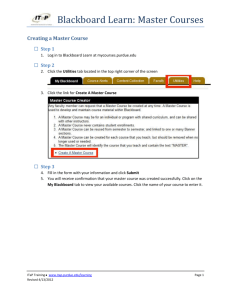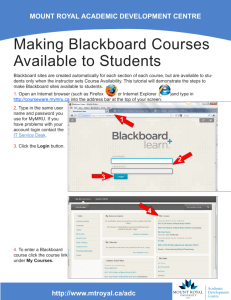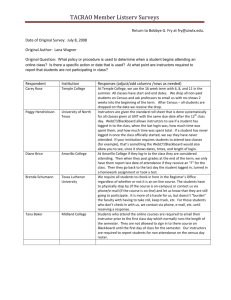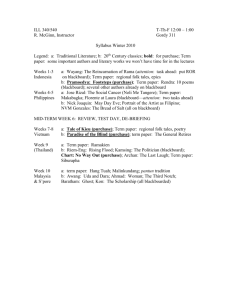Application Pack 1
advertisement
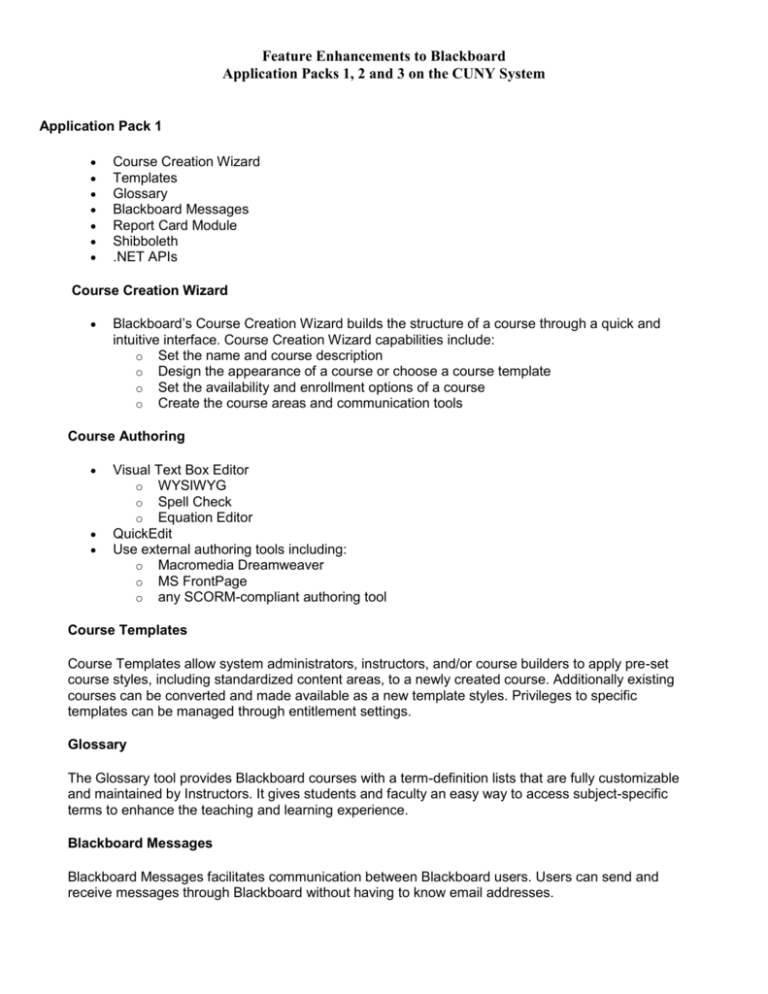
Feature Enhancements to Blackboard Application Packs 1, 2 and 3 on the CUNY System Application Pack 1 Course Creation Wizard Templates Glossary Blackboard Messages Report Card Module Shibboleth .NET APIs Course Creation Wizard Blackboard’s Course Creation Wizard builds the structure of a course through a quick and intuitive interface. Course Creation Wizard capabilities include: o Set the name and course description o Design the appearance of a course or choose a course template o Set the availability and enrollment options of a course o Create the course areas and communication tools Course Authoring Visual Text Box Editor o WYSIWYG o Spell Check o Equation Editor QuickEdit Use external authoring tools including: o Macromedia Dreamweaver o MS FrontPage o any SCORM-compliant authoring tool Course Templates Course Templates allow system administrators, instructors, and/or course builders to apply pre-set course styles, including standardized content areas, to a newly created course. Additionally existing courses can be converted and made available as a new template styles. Privileges to specific templates can be managed through entitlement settings. Glossary The Glossary tool provides Blackboard courses with a term-definition lists that are fully customizable and maintained by Instructors. It gives students and faculty an easy way to access subject-specific terms to enhance the teaching and learning experience. Blackboard Messages Blackboard Messages facilitates communication between Blackboard users. Users can send and receive messages through Blackboard without having to know email addresses. Report Card Module Provides a module that gives a simple summary of the user's total grades in all of the courses in which they are enrolled. Shibboleth Internet2 Middleware initiative that supports inter-institutional sharing of web resources subject to access controls Provides a framework that will allow inter-operation within the higher education community. Allows user to authenticate themselves amongst trusted sites using the same login id/password credentials. .NET APIs Example of Gradebook Access Through Excel - Programmatically interact with Blackboard applications using .NET to create or extend Content Types, Communication and Collaboration Tools, Modules and Channels, and Bridges to External Systems. Application Pack 2 Tool Linking Multi-Institution Branding and Management Role Based Information Delivery Unlimited Roles and Multiple Roles per User Assessment and Survey Results Download SCORM Player ChalkBox Support Tool Linking When a user adds material to a content page in the course environment, they can also directly add a discussion board forum, a live chat, or any tool directly in any area of the course with just one click. Multi-Institution Branding and Management Facilitates separation of multiple institutions, departments, or groups on one Blackboard server. For example, separate schools can be given their own domain and the ability to manage and brand their domain with the appropriate look-and-feel, including different colors, logos, tabs, modules, and channels. Delegated Administration allows System Administrators to assign domain-specific administrative tasks to individuals within that domain, allowing each to independently manage their own content and configuration. System Administrator can also assign to individual users or groups the management of portions of the system including courses, user management, tabs, modules, brands, and content collections. Role-based Information Delivery Availability of tabs, modules, channels, tools, and courses and organizations can be based on institution roles allowing for targeted delivery of content and information. For example, the institution could create a tab that would be visible only to users with the Faculty role, and within that tab, a “School of Business Faculty News” module which would only be available to users who are Faculty members in the School of Business. Unlimited Roles and Multiple Roles per User Institutions are able to add as many roles to the system as they wish. Previously the Bb Community System was limited to 20 roles. Users can now also have multiple institution roles assigned to them. For example a user can be a graduate student, a TA, a member of the Political Club, and belong to the East Campus. A user will have access to all of the modules, tabs, and other information resources available to all of their assigned roles. This feature is only available to institutions that have the Bb Community System. Assessment Survey Results Download This feature allows instructors to download the results from the attempts of a test or survey to an outside application such as Microsoft Excel. This allows further statistical analysis of the test/survey results outside of Blackboard. SCORM Player Allows instructors to import package files that have been developed according to SCORM 1.2, SCORM 2004 or IMS specifications into their courses. Additionally, SCORM or IMS content can interact with the Gradebook. Students can view content in courses just like any other content type. ChalkBox Support Allows instructors and students to connect seamlessly with high quality interactive learning tools. Applications are available from publishers in specific disciplines. Chalk Titles link seamlessly to the Gradebook and automatically stay in-synch with class rosters. Application Pack 3 Multi-Language Support by Institution, Course and User Review Status Adaptive Release Advanced Assessment Questions Assessment Question Completion Status Randomize Multiple Choice Answers Assessment Creation Metadata Options Performance Dashboard Syllabus Builder What’s New Module SCORM 2004 Advanced Course Menu Gradebook Null Option e-Commerce e-Marketplace Direct Access Branding Module Tab Enhancements Additional Bb Content System Integration Building Blocks for Bb Content System User Interface Multi-Language Support by Institution, Course and User Enables institutions to run multiple languages on the same system. To support cross-border education as well as foreign language courses, instructors can set the language of the course independently from the language setting of the overall system. In addition to supporting most European languages, Blackboard supports multi-byte character sets such as Japanese and Chinese. Review Status Content items include a setting that allows students to mark those items as “Reviewed”. The User Progress page reports which students have reviewed the content item. Adaptive Release Provides the ability for an instructor to create custom learning paths through course content and activities. Content items, discussions, assessments, assignments, or other activities can be released to students based on a set of criteria including: date/time, specific individuals, group membership, institutional role, grade on a particular test or assignment, or Review Status. Advanced Assessment Questions Allows the creation of additional questions types within assessments. Calculated Formula – Include calculations within the question. The calculations can have changing values within them for each exam. Calculated Numeric – Answer is a number or within a certain range of numbers. File Upload – Student answers the question by uploading a file. Hotspot – Student designates a “hotspot” on an image that was previously uploaded by the instructor. Either/Or – Answer is Yes/No, Agree/Disagree, Right/Wrong. Fill in Multiple Blanks – Type in free-form answers to multiple blanks within a sentence. Jumbled Sentence – Select from a drop-down of answers to fill in multiple blanks within a sentence. Opinion Scale/Likert – Answer is selection based on a scale such as Strongly Agree, Agree, Disagree, etc. Short Answer – Answer is typed into a free-form text box with a set limit. Assessment Question Completion Status Students may skip questions that they may wish to come back to in a question-by-question assessment. This feature allows students to clearly identify which questions they have actually completed from the ones that they have skipped as they progress through the assessment. Randomize Multiple Choice Answers Instructors have the option to randomize the answers in multiple choice questions. The answers are randomized for each assessment attempt, which helps prevent student cheating. Assessment Creation Metadata Options When creating an Assessment, Instructors have additional Creation Settings to set up metadata for questions. Metadata options include category and key words, degree of difficulty, and associations with learning objectives. Performance Dashboard A course tool that allows instructors to see key information and outcomes for all course users. The Performance Dashboard displays the last time each user logged in, their course role, Adaptive Release criteria, Review Status for content items, and grades. Instructors can sort the information by multiple criteria. Syllabus Builder Guides the instructor through a very simple process for building a syllabus without knowledge of HTML. The tool automatically generates lesson shells and the instructor chooses a pre-formatted style or creates a new one. What’s New Module This RSS-based module alerts users of any key changes or updates since the last time they logged in. Examples include: New institution-wide announcements, new assignments in courses they are enrolled in, new messages received through Blackboard Messages, etc. SCORM 2004 Support for SCORM 2004, the newest specification for SCORM packages. Instructors can add a SCORM gradebook category. In addition, instructors can view user attempt details, such as question responses, viewing time, and lesson status to assist in grading the item. Advanced Course Menu Commonly used tools are separated from the Course Menu to make them easier to find and use. The new Detail view lets users expand and collapse the Course Menu, and displays a clickable link to each item in the course. If allowed by the instructor, users can toggle between the default Course Menu view and the Detail view. Gradebook Null Option Excludes incomplete items from Gradebook calculations – items that have not yet been taken or graded can be excluded from grades, averages, and other calculations. e-Commerce Built in e-Commerce functionality allows an institution to charge for items via a student’s campus onecard or credit card. Items can include books, merchandise, a course, organization membership, or items sold by off-campus merchants. Institutions can also charge for course enrollment and group and organization membership fees. When connected to an institution’s Blackboard Transaction System students can view their account balance, transaction history, and deposit funds. e-Marketplace A built in e-Marketplace feature provides an online storefront capability and allows administrators to create multiple online stores. For example, the campus Chemistry Department could have one online store that sells equipment and supplies needed for labs and Campus Parking could have another store that sold parking passes. This feature enables the creation of a unified online campus shopping environment – a virtual mall. Direct Access Branding When Direct Access is enabled, branding can be applied not only to the top frame but also to the initial tabs and modules that appear to users. Module Tab Enhancements Enhancements to tab controls allow Administrators to create module tabs with one to three columns. They may also add a header and/or footer of variable width to any module tab, and designate module themes for the tab menu. Additionally, some administrative interfaces have been updated to increase usability and accommodate new features. Additional Bb Content System Integration Includes new functionality to allow courses and organizations to use the storage, search, and sharing capabilities of the Blackboard Content System. When uploading Assignments, SCORM, IMS and NLN content, file response (a new question type in Assessments), and Question Pools, users have the option of selecting a file from their local computer or from the Blackboard Content System. Building Blocks for Bb Content System User Interface Building on the Bb Content System APIs made available in Release 2.0, developers can now place their Building Blocks tools in the Blackboard Content System user interface. Blackboard Content System (Release 2.0) Learning Objects Catalog External Link Item Type Content System Public APIs Learning Objects Catalog Publish best-of-breed learning objects to a catalog with customizable category taxonomy. The feature includes the required workflow for submitting, approving and categorizing learning objects, and publishing them to an internal or external catalog. End users find high-quality learning objects by navigating the categories or by searching metadata External Link Item Type Users often place external links in their courses and organizations, and these links frequently break as URLs change and external sites become unavailable. Manage assets that exist in third-party systems just like any other item type, using permissions, metadata, versions, and workflow. Librarians can link to e-Reserve items that reside in external library systems. Bb Content System Public APIs Building Block developers can create tools for the Blackboard Content System. These plug-ins can be placed in various locations in the user interface. Java APIs extend all critical Blackboard Content System functions from basic file actions to permissions and quota management to workflow.
